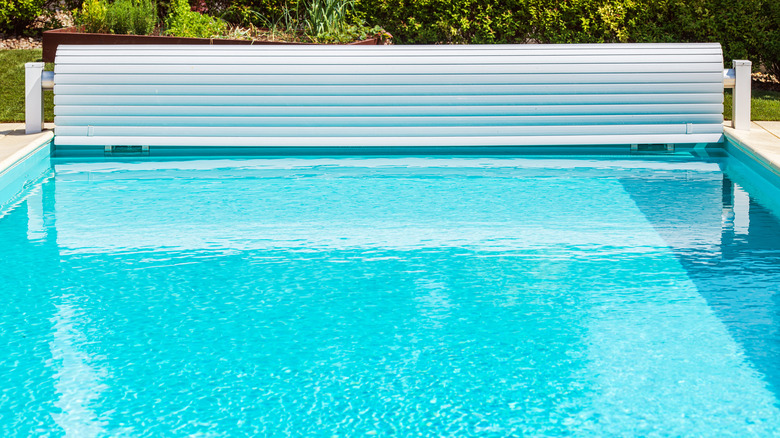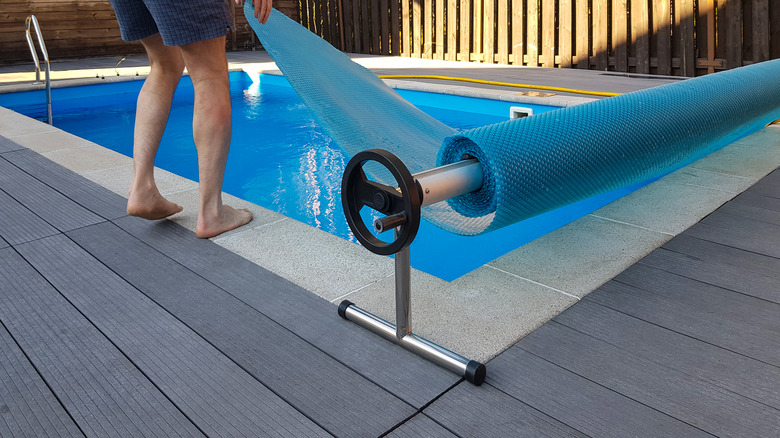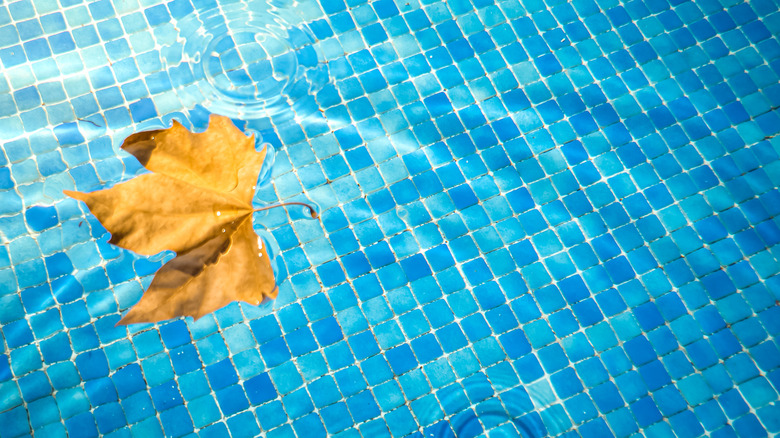What You Need To Know About Solar Pool Covers
If you have an outdoor swimming pool, chances are you've put it somewhere that also catches a decent amount of sunlight. Solar power has always been the simplest way to heat water to swim in, whether it's the sea, a lake, or an amazingly designed swimming pool in your backyard. According to Dummies, the most effective and most cost-effective solar heating system out there is a solar pool cover. You can get one large enough for an average-sized pool for a few hundred dollars, and they can extend the usable season of your pool by weeks or even months at either end of the summer.
Solar pool covers look a lot like regular pool covers — at their most basic, they are plastic sheets that cover the surface of the water, stopping debris from falling in. They can be darkly colored to absorb heat from the sun or made of clear, bubble-filled plastic, a bit like bubble wrap.
What solar pool covers don't do is stop children or animals from falling into the pool. They float on top of the water, stopping water from evaporating, and retaining heat from the sun. In an in-ground pool, this can amount to a 5-degree Fahrenheit increase in pool water temperature when covered for 12 hours at a time.
What are the benefits of solar pool covers?
According to the US Department of Energy, using a swimming pool cover can dramatically reduce the costs of keeping your pool heated. Even using a basic plastic sheet will — if fitted correctly — stop evaporation, like putting a lid on a boiling pot on the stove. Though plastic sheets that aren't designed for pools are likely to rip and only last about one summer with the chemicals and UV exposure.
Evaporation accounts for up to a 70% of energy loss and a loss of up to 75% of the heat for both indoor and outdoor pools. It also removes the water in your pool and some of the chemicals you use to keep your pool clean. So as well as higher water bills, unchecked evaporation can also lead to inaccurate chemical concentrations.
The insulating power of a solar pool cover doesn't just increase the water temperature for the spring and fall months when you might otherwise not be able to swim. Medallion Energy emphasizes the stabilizing effect of better pool insulation. If you live somewhere where summer sunshine is inconsistent, having a solar pool cover will make sure that your pool is still toasty warm, even if the sunshine decides to hide for a few days!
Three different types of solar pool cover
Solar blankets look like a regular pool cover, but as mentioned above, they might be a thick layer of dark material that absorbs and retains the sun's heat, or something like bubble wrap, which allows the sun's rays through and traps the heat underneath like a greenhouse. These can concentrate UV rays into the pool and break down chlorine at a faster rate, according to Swimmingpool.com, so test regularly. They have a lifespan of one to three years.
Solar rings are an option for those with eccentrically-shaped pools or who prefer a more decorative approach than 'cover it with a fancy tarp.' Per PoolCareGuy, solar rings are a collection of smaller plastic shields that connect to each other with magnets. They won't cover the whole pool, though, so they're less efficient than the full blanket. Solar rings often have some gaps between them and at the edge of the pool, which will, of course, be a magnet for debris.
For those who want to give the illusion of an open pool but still address the problem of evaporation, the best option is a Liquid Solar Cover, as detailed by Auto Pool Reel. These are chemical solutions that form an invisible layer on top of the water's surface. They are non-toxic and still very effective at stopping evaporation. Of course, they won't stop debris from falling into the pool and can be quite expensive over time, as you have to add more chemicals each month.


